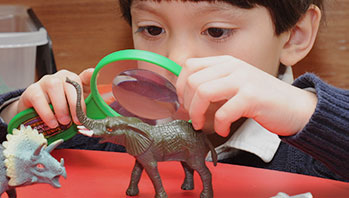- picture cards (baby animals and corresponding animal mothers)
- different
- same
MA Standards:
Language/L.PK.MA.5.a: Demonstrate understanding of concepts by sorting common objects into categories (e.g., sort objects by color, shape, or texture).
MA Draft STE Standards
Physical Sciences/Matter and Its Interactions: Structure and Properties of Matter: PS1.A: Describe, compare, sort and classify objects based on observable physical characteristics, uses, and whether it is manufactured as part of their classroom play and investigations of the natural and human-made world.
Life Sciences: From Molecules to Organisms: LS1/3.E: Describe differences and similarities between young animals and their parents.
Life Sciences: From Molecules to Organisms: LS1/3.F: Identify similarities and differences among individuals of the same species. [Patterns]
Head Start Outcomes:
Logic and Reasoning/Reasoning and Problem Solving: Classifies, compares, and contrasts objects, events, and experiences.
PreK Learning Guidelines:
English Language Arts/Language 4: Engage in play experiences that involve naming and sorting common words into various classifications using general and specific language.
Mathematics/Patterns and Relations 8: Sort, categorize, or classify objects by more than one attribute.
Matching Game

© Commonwealth of Massachusetts, Department of Early Education and Care (Jennifer Waddell photographer). All rights reserved.
Hold up a picture of a mother and a baby. Talk about things that are the same about the two family members.
Then hold up a picture of a baby animal and its mother. Talk about things that are the same about the two animals. Then tell children they are going to work with a partner to find pictures of baby animals and their mothers. Explain that they will use the animal cards to match baby animals to their mothers.
Engage children as they find matching animals and encourage them to discuss why they are choosing specific animals as a match. Ask questions such as,
- What did you notice about the two animals that made you think it was a match?
- Can you tell me something that is the same about the two animals? Something that is different?
- Do you know what a baby cat is called? Do you have a cat or a kitten at home?
Have children name one thing that is the same about each match. Ask them to point out something that is different about pictures that do not match.
Adaptation: In groups with younger children, help children identify things that are the same about the baby and mother animals.
English Language Learners: Help children relate to the key vocabulary terms for this activity, same and different. As children look at two pictures, have them point out something that is the same in each animal (e.g., number of legs). Hold up a third picture that has the same feature (number of legs) and ask, Does this animal have the same <number of legs>? Continue with similar and different features until children grasp the meaning.
